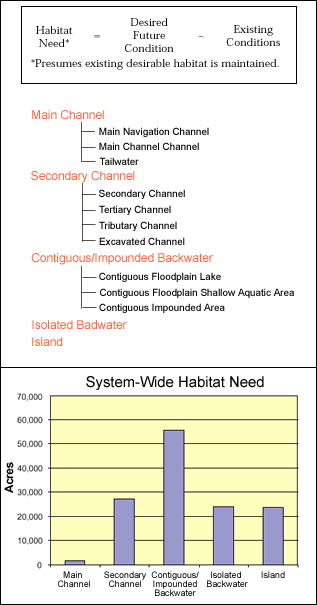|
The EMP Habitat Needs Assessment defines habitat "needs" as
the difference between "existing conditions" and "desired
future conditions." To calculate "need,"  a
system-wide accounting of existing, predicted, and desired habitat conditions
was thus developed. This effort revealed some clear differences among
river reaches. For example, land cover analysis clearly documents an abundance
of certain valuable habitat types in northern river reaches, versus a
scarcity of those habitats in southern river reaches. The differences
are largely related to the amount and distribution of public land, the
degree of floodplain development, the geomorphic form of the river, and
effects of impoundment for navigation. In addition, analysis of geomorphic
changes indicates that some changes (such as loss of backwaters) are systemic,
while other changes (such as island dissection) are more localized. Understanding
these differences can help identify what types of restoration efforts
are most appropriate for each river reach. a
system-wide accounting of existing, predicted, and desired habitat conditions
was thus developed. This effort revealed some clear differences among
river reaches. For example, land cover analysis clearly documents an abundance
of certain valuable habitat types in northern river reaches, versus a
scarcity of those habitats in southern river reaches. The differences
are largely related to the amount and distribution of public land, the
degree of floodplain development, the geomorphic form of the river, and
effects of impoundment for navigation. In addition, analysis of geomorphic
changes indicates that some changes (such as loss of backwaters) are systemic,
while other changes (such as island dissection) are more localized. Understanding
these differences can help identify what types of restoration efforts
are most appropriate for each river reach.
Though differences among reaches are significant, resource managers have
generally concluded that habitats are currently degraded and expected
to get worse. The factors responsible for degradation (e.g., sedimentation,
impoundment, channelization, levees, etc.) also suggest the most promising
avenues for ecological restoration.
Quantitative assessments of need are obviously difficult and thus do
not provide precise estimates of change or need. Nor do the gross quantitative
estimates suggest precisely where on the river changes are needed. Nevertheless
this initial assessment, based on input from resource managers and scientists,
identifies which types of geomorphic areas need emphasis in various river
reaches and pools to achieve the broad restoration objectives.
|
Estimates of needs are expected to nearly double by 2050 if no action
is taken. |
|
|
System-wide Habitat Needs
- Create or restore:
- 1,700 acres of main channel habitat
- 27,000 acres of secondary channel habitat
- 55,500 acres of contiguous backwater habitat
- 24,000 acres of isolated backwater habitat
- 24,000 acres of island habitat
|
Upper Impounded Reach (Pools 1-13) Needs
- Create or restore:
- 3,500 acres of main channel (i.e., main channel, channel
border, and tailwater) habitat
- 9,300 acres of secondary channel habitat
- 24,000 acres of contiguous backwater or impounded backwater
habitat
- 5,800 acres of isolated backwater habitat
- 1,000 acres of island habitat
|
Lower Impounded Reach (Pools 14-26) Needs
- Reduce main channel habitat by 1,800 acres
- Create or restore:
- 9,000 acres of secondary channel habitat
- 10,500 acres of contiguous backwater habitat
- 5,000 acres of isolated backwater habitat
- 3,000 acres of island habitat
|
Open River Reach Needs
- Create or restore 25,000 acres of backwater and secondary channel
habitat, of which 7,000 acres should be isolated backwaters
- Increase the amount of prairie, marsh, and forest by about 100,000
acres
- Restore geomorphic processes that create and maintain sand bars
and shoals
|
Illinois River Needs
- Restore existing backwaters so that 25 percent of backwater
lakes (19,000 acres) have an average depth of 6 feet
- Increase depth diversity and connectivity throughout the river
- Restore hydrologic variability needed to restore and maintain
existing backwater habitats
|
|